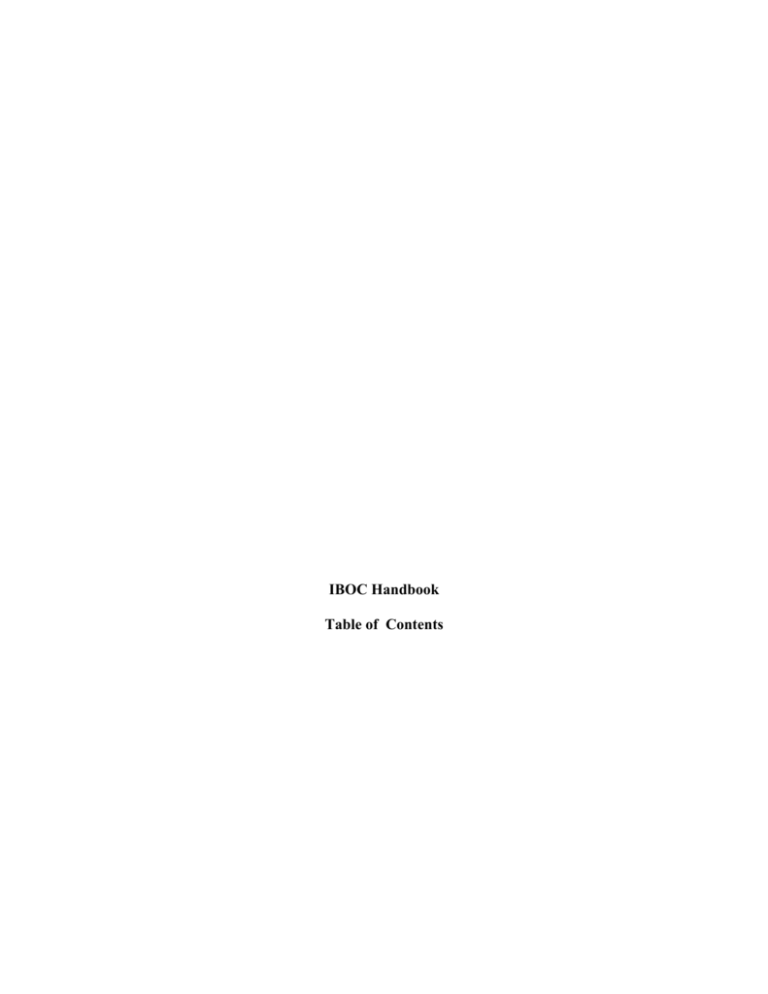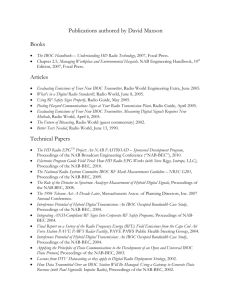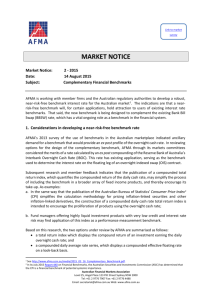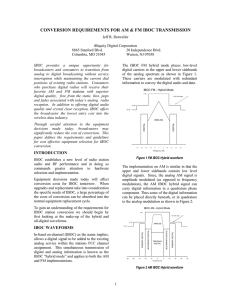What is IBOC Radio - The IBOC Handbook
advertisement

IBOC Handbook Table of Contents Section I - Background Chapter 1 What is IBOC Radio? Services Overview Program Services Multicasting Tomorrow Radio The HD Digital Radio Alliance Program Service Data (PSD) Station Information Service (SIS) Advanced Data Services (ADS) HD Radio Data Enhancements The Digital Radio Environment FCC First Report and Order Dissent The Rise of IBOC The NRSC and IBOC Development NRSC Test and Evaluation Process Digital Radio Transmission Technologies Eureka-147 DAB Cam-D DVB-T DVB-H Integrated Services Digital Broadcasting for Terrestrial Sound Broadcasting (ISDBTSB) Satellite Digital Audio Radio Services (SDARS) XM and Sirius Satellite Radio SDARS Terrestrial Repeaters Worldspace Satellite Extended Digital Services Digital Radio Express (DRE) Stratos Audio Inc. and StratosInteractive A Context For IBOC Chapter 2 IBOC Precursors IBOC’s Beginnings New Technical Muscle NRSC Cranks It Up Testing Proponents’ Technologies: TGWG Regulatory Progress Evaluation Process: EWG Standardization Testing: TPWG and EWG Response to the Testing Finally, Standards-Setting: ISDWG FM Subcarrier Compatibility: DAB Subcommittee and Others The Path to the HDC Codec: TPWG and EWG AM Nighttime Performance and Compatibility: Outside-NRSC Review Multicasting and the SIDTG Surround Sound: The SSATG Composite Surround Transport Component Surround Transport Surround Sound Case Studies KUVO-FM, Colorado Public Radio WZLX 100.7, CBS Boston WGUC-FM 90.9, Cincinnati Public Radio A Complete Standard in Two Steps: Data Put on Temporary Hold After the Standard: DRB Subcommittee Moving On Section II – The Protocol Stack Chapter 3 NRSC-5 Versions Reference Documents Informative References The NRSC-5 Standard Protocol Stack Open Systems Model NRSC-5 As Open System One Standard, Several Modalities “Services” Versus “Transports” Structure of Section 2 Chapter 4 Audio Codec Coded Audio Payload Side Processes: The Configuration Administrator Audio Transport Program Service Data (“PSD”) MPS and SPS PDU’s Opportunistic Data Program Service Data PSD Protocol and Transport PSD ID3 Tags PSD Etiquette PSD Harmonization with RDS PSD Transport PSD Metadata Audio Transport to Channel Multiplex Chapter 5 Logical Channels Logical Channels and the Frequency Domain Logical Channels in the Time Domain Logical Channel Types and Rates Layer 2 PDU Structure Folding in Data L2 PDU Types Layer 1—Processes Common to AM and FM Scrambling The Spectral Challenge of OFDM How Scrambling Works Convolutional Coding Vectors and Matrices FM IBOC Rate 2/5 Encoder Example Puncturing How Convolutional Encoding Helps A Diagram Is Worth a Thousand Words Puncturing Interleaving Layer 1 Continues Chapter 6 Layer 1 Structure System Control IBOC in the Time Domain Audio Sampling Rate Implications Frame and Block Duration Diversity Delay AM Time Diversity FM Time Diversity The Symbol Sync-ing Up System Control Processing Differential Encoding Universal Time Service Modes AM Service Modes FM Service Modes Backward Compatibility From Logical to Physical Chapter 7 FM IBOC OFDM Spectrum FM IBOC OFDM Frequency Plan FM IBOC OFDM Modulation: Symbols Constellation FM IBOC OFDM Modulation: Computational Basis Convolution OFDM Sinusoidal Subcarriers OFDM Symbol Pulses Guard Interval Cyclic Prefix Pulse Shaping Function Discrete Fourier Transform Windowing Functions in Frequency and Time Domains DFT Computation Insert Pulse Shaping Function A Stream of Symbols Convolution Revisited Chapter 8 AM IBOC OFDM System AM Parameters Modulation Amplitude Scaling The Negated Complex Conjugate Analog Channel Complex Conjugate Interference Protection AM Pulse Shaping Chapter 9 AM and FM Transmission System Specifications Timing Issues Signal Quality Issues Error Vector Magnitude Phase Noise Flatness AM Amplitude and Phase Symmetry Where to Measure AM and FM IBOC Specs Spectral Emissions Spectral Emissions Limits Existing Analog Masks IBOC Masks Spectral Density PSD and Spectrum Analyzer Settings Spectrum Analyzer Detectors and Averaging FM Mask Digital-to-Digital Intermodulation Analog/Digital Intermodulation NRSC-5-A Mask (Hybrid FM IBOC) Digital Sideband Self-Intermodulation Hybrid Mask Fine Tuning NRSC-5-A Mask (All-Digital FM IBOC) OFDM Subcarrier Scaling AM Mask Analog-to Digital and Digital-to-Digital Intermodulation NRSC-5-A Mask (Hybrid AM IBOC) Analog Host Performance with Hybrid NRSC-5-A Mask (All-Digital AM IBOC) Discrete Components Exception OFDM Subcarrier Scaling IBOC or IBAC? IBAC Characteristics Differ From IBOC The Radio "Channel" Chapter 10 Station Information Service Protocol Station Name (Short Format) a.k.a. Call Sign Standard Call Sign Universal Station Name (Long) a.k.a. Station Slogan Standard Station Slogan Universal Station ID Number Station Location Station Message Time – ALFN and Time Parameters ALFN Leap Seconds SIS Parameter Messages Leap Second Offsets Local Time Data Station Information Service Transport Dedicated GPS Time Data SIS PDU Housekeeping SIS Scheduling Strategy SIS Recap Chapter 11 Advanced Applications Services Transport (AAT) Data Transport Packet AAT PDU AAT PDU Stream Reed-Solomon FEC Interleaving Block Boundaries Bearer Channels Data Transport Packet Format Port Number Sequence Number HDLC-Like Framing Reed-Solomon Coding and Interleaving Insertion into Bearer Channel Opportunistic BearerError! Bookmark not defined. Fixed Bearer Above AAT— What Happens Outside NRSC-5? Learning from History A Better Reason to Use AAT Subchannels The Radio Broadcasting Model for Advanced Data Services Revenue Comparisons Network Design Modeling The Flow of IBOC Transmissions The Concept of Multiple Services Sharing the Pipe Use Cases and Service & Receiver Classifications Applications Examples Features Examples Service Classes Use Mapping Receiver Classes Classes Are the Key to Interoperability Use Cases Lead to Protocols Advanced Data Service Protocols (Not in NRSC-5) Service Discovery Telematics Traffic Message Channel End of the IBOC Stack Section III - Implementation Chapter 12 AM IBOC Our AM Legacy Backward Compatibility What is Bandwidth, and What Does It Mean to Us? Propelled from the Jet Age to the Space Age Invisible IBOC Antenna System Effects on the AM IBOC Signal Outermost, or Primary, Sidebands Outer or Secondary Sidebands Inner or Tertiary Sidebands Self-Canceling Sidebands Transmitter Loading and System Bandwidth Hermitian Symmetry Measurement Analog’s Regulatory Vicious Cycle Intermodulation Products Pattern Bandwidth High-Performance, Precision Antenna Systems Nighttime AM Testing and Analysis Conclusion Chapter 13 Antennas and Combining Analog FM Signals Multi-station Combining Combining Digital Signals in the FM Band Common Amplification Co-Synthesis Low-Level Combining High-Level Combining The High-Level Combiner Why a 10-dB Combiner? Efficiency and Heat Load Mismatch and Isolation Turn-around Loss Minimizing Unwanted Interaction Directivity Isolation Split-level Combining Efficiency Considering the Options Isolation Combining with Antennas The IBOC-to-Antenna Path Dual-Feed Antenna Separate-Antenna Operation Separate-Antenna Research Separate-Antenna Regulation Multi-Station Antenna Systems Common-Line IBOC to Multi-Station Combiners Separate-Line IBOC and Multi-Station Combining Crest Factor and Peak Power in Hybrid IBOC Transmission OFDM Peak to Average Relate OFDM to Analog OFDM Peak to Analog Peak OFDM RMS to Analog RMS Hybrid Crest Factor Difference Between Hybrid and Analog Crest Factors Chapter 14 Transmission The Exciter The Exgine Connecting the Services to the Transmitter Main Program Audio Economizing for Multicasting The Exporter Breaking into the Protocol Stack A New Transport Where None Had Been Necessary Before Network Analysis Quality of Service Network Security Another Approach The Importer Secure the Critical Network Reception Core Receiver Components IBOC Coverage FM Evaluation Further FM Testing Adjacent Channel Interference AM Evaluation Core & Enhanced Nighttime Effect of Adjacencies on AM IBOC Coverage Conclusion of the IBOC Handbook Appendix A: IBOC Digital Radio Receiver Fundamentals By DAVE WILSON, Consumer Electronics Association




